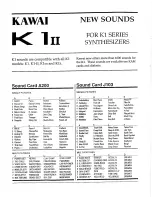Summary of Contents for OB-Mx
Page 1: ...OB M x User s Guide Oberhefm ...
Page 6: ...iv OB Mx User s Guide ...
Page 8: ...OB Mx User s Guide Section 1 Introduction Oberheim ...
Page 24: ...16 OB Mx User s Guide ...
Page 38: ...30 OB Mx Users Guide ...
Page 39: ...O B Mx User s Guide Section 2 Reference Oberheim ...
Page 45: ...36 OB Mx User s Guide ...
Page 67: ...58 OB Mx User s Guide ...
Page 79: ...70 OB Mx User s Guide ...
Page 83: ...74 OB Mx User s Guide Output Level 100 Sustain Level Note OK Figure 10 1 An OB Mx envelope ...
Page 95: ...86 OB Mx User s Guide ...
Page 101: ...C 2 OB MX User s Guide Multi Program Record OB Mx MultiProgram Record ...
Page 103: ...C 4 OB Mx Matrix Table MATRIX SOURCES AND DESTINATIONS Patch 1 12 ...
Page 104: ...MIDI Implementation Chart C 5 ...



































